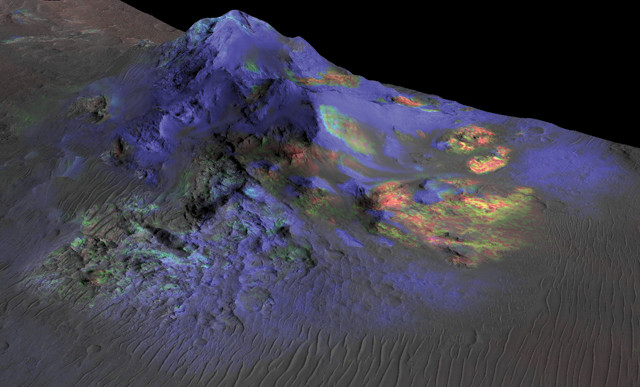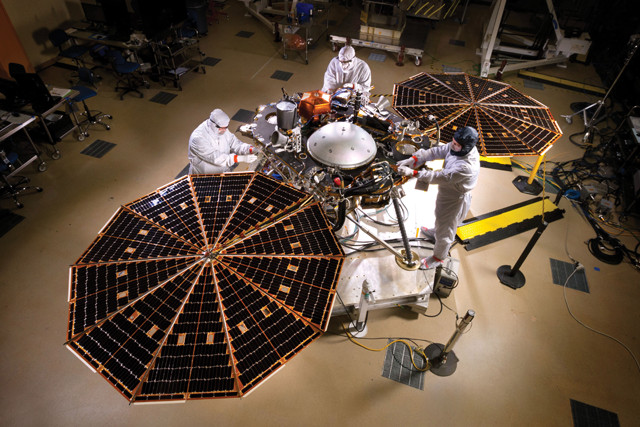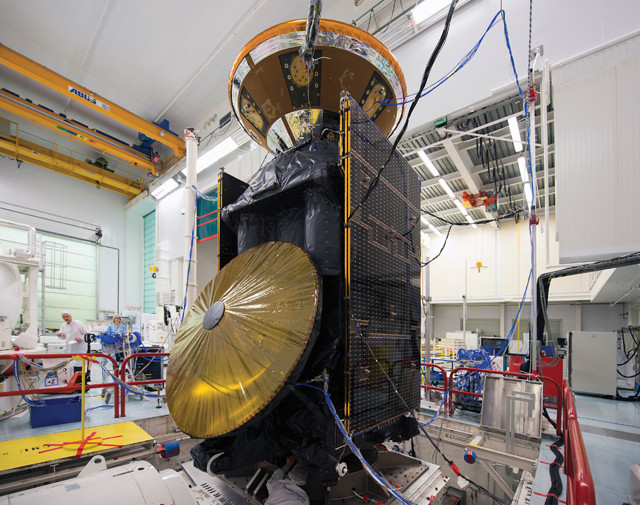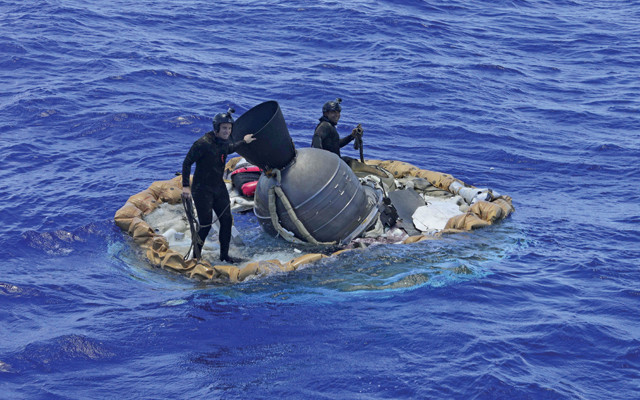
by Timothy Oleson Tuesday, August 25, 2015

Areas shaded green in this image show where signs of impact glass were identified near the central peak of Alga Crater in Mars' southern hemisphere. Credit: NASA/JPL-Caltech/JHUAPL/Univ. of Arizona.

The InSight lander undergoes testing in a facility at Lockheed Martin Space Systems in Denver, Colo., in April. Credit: NASA/JPL-Caltech/Lockheed Martin.
With two rovers patrolling the surface of Mars, five spacecraft orbiting above it, and scientists here on Earth studying the Red Planet from afar, new findings are announced often. Here are a few of the latest updates.
Scientists have spotted signs of impact-induced glass for the first time on Mars. Such glass, which forms when rock melted by the heat generated in asteroid or large meteorite impacts cools rapidly, has previously been found to preserve evidence of past life on Earth. Analyzing data collected by NASA’s Mars Reconnaissance Orbiter, Kevin Cannon and John Mustard of Brown University identified likely spectral signals from impact glass located near the centers of several Martian craters. The findings, reported in Geology, raise the possibility that if life existed on Mars when these crater-forming impacts occurred, then traces of it could still be entombed in the glass. “These areas could be targets for future exploration,” noted Jim Green, NASA’s Director of Planetary Science, in a press release.
After NASA’s MAVEN spacecraft observed aurorae shining at ultraviolet wavelengths — typically invisible to humans — over much of Mars’ northern hemisphere earlier this year, new research suggests that Mars’ aurorae may in fact be visible after all. These aurorae would mostly appear blue to humans standing on Mars, a result of high-energy solar particles interacting with carbon dioxide in the Red Planet’s atmosphere, although red and green emissions from oxygen would also probably occur, according to Jean Lilensten of the Institute of Planetology and Astrophysics of Grenoble in France and colleagues. The new findings, published in the journal Planetary and Space Science, arose from numerical modeling as well as laboratory experiments using a device called a Planeterrella, which allowed the researchers to simulate the interactions of charged particles with Mars’ atmosphere and patchy localized magnetic fields.
Perchlorate salts, abundant and widespread on Mars compared to Earth, present a potential energy source for microbes on Mars — if there are or ever were any — as well as a potential hazard for continued exploration missions, given perchlorates’ corrosivity. Most naturally formed perchlorate on Earth is created through photochemical reactions in the atmosphere, but similar pathways don’t seem to explain the high concentrations in Martian soils — upward of half a percent. By simulating soil and atmospheric conditions on Mars, Brandi Carrier and Samuel Kounaves of Tufts University in Medford, Mass., found that silica and metal oxides in the soil can catalyze the breakdown of molecular oxygen by solar ultraviolet radiation to form highly reactive oxygen radicals. These radicals can then react with chloride minerals like halite in the soil to form perchlorates. The results suggest that “input by this mechanism, along with input from others, could explain the high concentrations of perchlorate detected on Mars,” the researchers wrote in Geophysical Research Letters. The results also suggest that perchlorate formation is likely “occurring globally on a continuous basis wherever chloride-bearing mineral phases exist.”

The ExoMars 2016 spacecraft, comprising the Trace Gas Orbiter and the Schiaparelli module (at top), is being prepped for a January 2016 launch. Credit: ESA, S. Corvaja.

Members of the U.S. Navy's Mobile Diving Salvage Unit 1 Explosive Ordnance Detachment sit atop the Low-Density Supersonic Decelerator vehicle in the Pacific Ocean off Kauai in June. Credit: U.S. Navy.
After completing the assembly phase, NASA has begun environmental tests on its next Mars-bound spacecraft, InSight, including subjecting it to extreme temperatures and pressures, as well as vibration and electrical tests to ensure it can handle its launch and six-month trip through space. InSight is a lander that will study the structure of and heat transport in the planet’s interior; it is slated to launch in March 2016.
Scheduled to launch two months earlier in January 2016 is the first stage of the European Space Agency’s (ESA) two-part ExoMars mission (the second stage is a rover set to launch in 2018). The spacecraft is currently undergoing environmental and mechanical testing. The spacecraft consists of an orbiter that will study trace gases like methane in the atmosphere, as well as an entry, descent and landing module — nicknamed Schiaparelli — intended to demonstrate ESA’s landing technology. In April, the two components were assembled together for the first time.
Meanwhile, earlier this summer, a test run of a next-generation parachute — intended to help lower larger payloads to Mars’ surface than have been delivered before — did not go as hoped. High in the atmosphere over the Hawaiian island of Kauai, the 30-meter-wide parachute tore apart after deployment from NASA’s Low-Density Supersonic Decelerator (LDSD) while it was falling at speeds close to Mach 3. NASA officials noted that working out design flaws is why thorough testing is conducted on Earth before sending craft into space, and that other elements in the LDSD design had worked as planned. “The physics involved with LDSD is so cutting-edge we learn something profound every time we test,” said Ian Clark, principal investigator for LDSD at the Jet Propulsion Laboratory in Pasadena, Calif., in a statement.
© 2008-2021. All rights reserved. Any copying, redistribution or retransmission of any of the contents of this service without the expressed written permission of the American Geosciences Institute is expressly prohibited. Click here for all copyright requests.